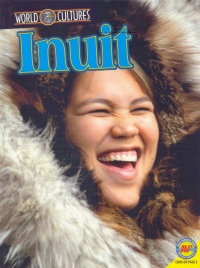| ________________
CM . . .
. Volume XIX Number 18. . . .January 11, 2013 
 |
Inuit. (World Cultures).
Leslie Strudwick.
New York, NY: Weigl (Distributed in Canada by Saunders Book Company), 2013.
32 pp., pbk. & hc., $13.95 (pbk.), $24.99 (hc.).
ISBN 978-1-61913-530-7 (pbk.), ISBN 978-1-61913-092-0 (hc.).
Subject Heading:
Inuit-Juvenile literature.
Grades 4-7 / Ages 9-12.
Review by Rachel Yaroshuk.
*** /4
|
| |
|

excerpt:
For decades, the indigenous peoples of the Arctic were called "Eskimos." The Objibwa Native Peoples gave them this name.... Linguists now believe the word Eskimo means "to net snowshoes." The word Inuit, which means "the people," was made the official name of the Arctic Peoples in 1977. Inuit is the word used to describe the entire group of these indigenous peoples. One member of the group is called an Inuk.
Weigl Educational Publishers has expanded their Aboriginal non-fiction titles to include updated material in their "World Cultures" series. There are six titles in total: Aboriginal Australians, Bushman of Southern Australia, Inuit, Maasai, Maori, and Polynesians.
Each book in the series begins by orientating readers to the traditional lands of the represented culture. It then introduces stories and legends of the culture, social structures and governance, language and cultural goods, food and dress. Most pages include information boxes to highlight important facts. The books also include a timeline to mark historically significant events in the geographic area of the Indigenous cultures. The information provided in the "World Cultures" series is detailed, making it appropriate for older children. Most complex vocabulary is defined in the "Key Words" section located at the end of the book.
The text quantity per page is well balanced with engaging colour photographs, maps, and illustrations. The backgrounds are also adorned with colourful motifs to engage the child audience. Inuit includes prompts for developing a debate, as well as a brief quiz to test readers' knowledge. There is also an AV2 component which offers a more interactive game-like experience for readers whereby they can watch videos, listen to audio uploads, browse web links, takes quizzes, view slide shows and participate in activities online. Finally, the books include an index for easy reference. This is a fabulous resource to drawn on when teaching children how to engage with information texts.
This series acts as an excellent classroom resource for children learning about Indigenous peoples. I would recommend this series for both for school projects and general interest.
Recommended.
Rachel Yaroshuk is a Master of Library and Information Studies student at the University of British Columbia in Vancouver, BC.

To comment
on this title or this review, send mail to cm@umanitoba.ca.
Copyright © the Manitoba Library Association. Reproduction for personal
use is permitted only if this copyright notice is maintained. Any
other reproduction is prohibited without permission.
NEXT REVIEW |
TABLE OF CONTENTS FOR THIS ISSUE
- January 11, 2013.
AUTHORS |
TITLES |
MEDIA REVIEWS |
PROFILES |
BACK ISSUES |
SEARCH |
CMARCHIVE |
HOME |
